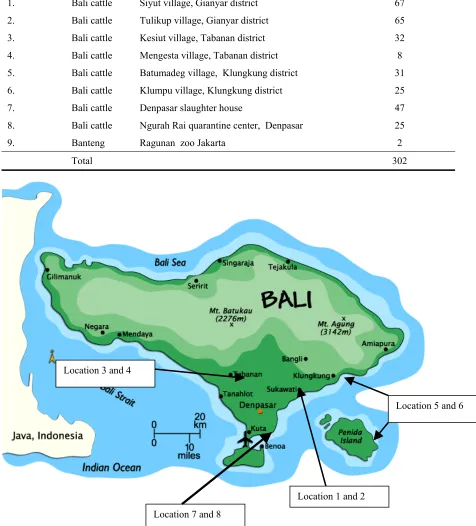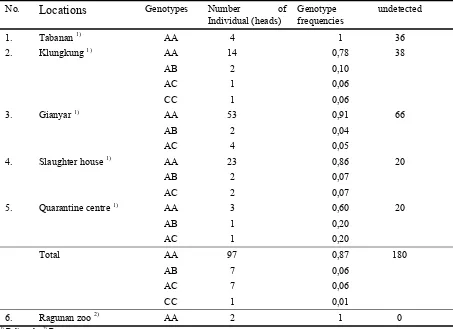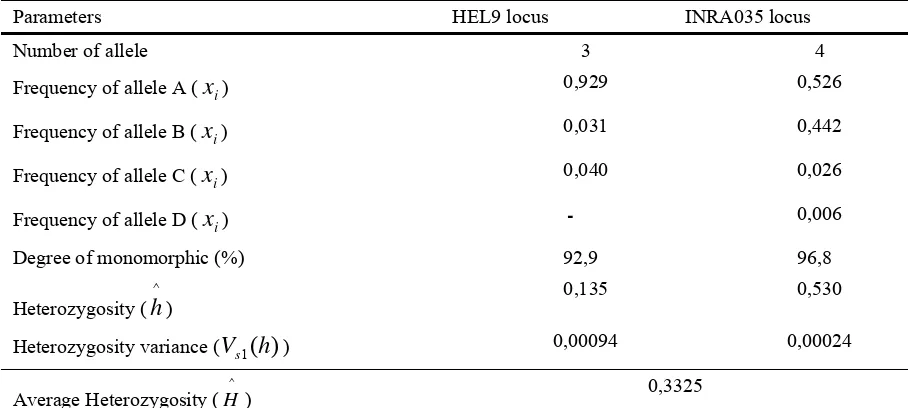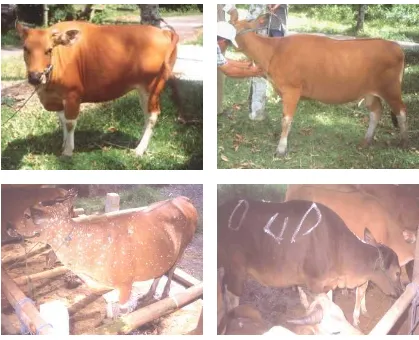Indonesian Research Centre and Livestock Development, Bogor, Indonesia1. Faculty of Animal Science, Bogor Agricultural University, Indonesia2, Institute of Animal Breeding and Genetics with Veterinary Clinic, Martin Luther
University, Halle-Wittenberg, Germany3
EKO HANDIWIRAWAN1, RONNY RACHMAN NOOR2, MULADNO2 and LUTZ SCHÜLER3
The Use of HEL9 and INRA035 Microsatellites as Specific Markers
for Bali Cattle
Dedicated toProf. Dr. sc. Günter Herrendörfer on the occasion of his 65th birthday
Abstract
Bali cattle are one of Indonesian native cattle’s that famous for their ability to adapt to tropical harsh conditions. For the last 25 years, indiscriminate crossbreeding using artificial insemination (AI) organizing mainly by government might be has contaminated the purity of Bali cattle. In order to utilize as well as to conserve Bali cattle it is necessary to develop an accurate and simples method to detect the purity of Bali cattle. This experiment is the continuation of a long term experiments in developing methods to detect the purity of Bali cattle i.e. phenotypic variations, blood protein polymorphisms, hair structure, chromosome and DNA microsatellite variation analyses. The specificity of HEL9 and INRA035 microsetellites in Bali cattle as well as in Banteng (Bos sondaicus) as their ancestor was tested.
The results show that A and B alleles at INRA035 microsatellite locus are monomorphic and can be used for a specific markers for Bali cattle. Allele A at locus HEL9 that has high frequency (92.90%) in Bali cattle and 100% in Banteng can also be used as a supporting marker.
Key Words: Bali cattle, DNA microsatellite
Zusammenfassung
Titel der Arbeit: Die Anwendung von Mikrosatelliten HEL9 und INRA035 als spezifische Marker für das Balirind
Das Balirind ist eine einheimische Rasse in Indonesien, die durch seine gute Angepasstheit an tropische Bedingungen gekennzeichnet ist. In den letzten 25 Jahren wurde unter Verwendung der künstlichen Besamung die Kreuzungszucht im Rahmen staatlicher Programme durchgeführt und so die Rasse verändert. Um das Balirind als reine Rasse zu nutzen und diese in Genreserven zu erhalten, sind einfache und genaue Methoden zu entwickeln, um die Reinheit der Balirinder zu überprüfen. Als geeignete Methoden zur Einschätzung der Reinheit der Rasse wurden die phänotypischen Varianzen von Merkmalen, die Blutgruppenpolymorphien, die Haar- und Chromosomenstruktur und die Anwendung von DNA Mikrosatelliten geprüft. Die Spezifität des HEL9 und INRA035 Mikrosatelliten im Balirind ebenso wie im Bantengrind (Bos sondaicus), der Stammform des Balirindes, wurden analysiert.
Die Ergebnisse der Untersuchungen zeigten, dass A und B Allele des INRA035 Mikrosatelliten monomorph sind und für das Balirind verwendet werden können. Das Allel A des HEL9 Mikrosatelliten tritt mit einer Frequenz von 92,40% im Balirind und mit 100% im Bantengrind auf und kann als zusätzlicher weiterer Marker genutzt werden.
Schlüsselwörter: Balirind, DNA-Mikrosatelliten
Introduction
adapt new environmental conditions (MARTOJO, 1990). Comparing with other
breeds, Bali cattle have better adaptation, especially in poor environment
(MASUDANA, 1990), because they can utilize low quality of feedstuffs
(SASTRADIPRAJA, 1990), have high reproduction rate (80% calving percentage),
have high carcass percentage (52-57.7%) (PAYNE and ROLLINGSON, 1973), have
high meat quality and low fat percentage (4%) and resistance to internal and external
parasites (PAYNE and HODGES, 1997; NRC, 1983).
Pure breeding of Bali cattle can be found at Bali Island, Sumbawa Island, Flores Island
and Bone district of South Sulawesi province (PANE, 1991). Indonesian Government
has allocated those islands as the main sources of pure Bali cattle. Crossbreeding can
only be conducted outside of areas. However, due to indiscriminate crossbreeding, the
pure Bali cattle at those areas have been contaminated with other breeds, i.e.
Simmental, Limousine, Brangus, Charolais, indicating by high frequency of abnormal
appearances, including abnormal colour patterns and horn shapes. So it is necessary to
develop accurate and simple methods that can detect the pure Bali cattle.
The methods for identifying the pure of Bali cattle has been developed and pioneered
by NOOR et al. (2000). They used iso-electrical focussing blood protein
polymorphism analyses, DNA microsatellite analyses, chromosome structure analyses
and hair structure analyses using scanning electron microscope. They suggested that
the Bali cattle in Artificial Insemination Centre at Singosari, Malang, West Java and in
Bali island might had been contaminated by other species of cattle. However, due to
the small sample size used the conclusion has not comprehensive yet.
NOOR et al. (2000) found that out of 15 microsatellite loci tested in Bali cattle,
Simmental, Brangus and
Limousine, only two loci, i.e. HEL9 and INRA035 were
specific for Bali cattle. Based on the result, only these two loci were used in this
experiment. WINAYA (2000) using limited number of animal found that HEL9
microsatellite locus is monomorphic in Bali cattle, but not for Madura, Ongole and
Brangus breeds. NOOR et al. (2000) were also found the same result using Bali cattle,
Simmental, Brangus and Limousine. In addition, INRA035 locus in Bali cattle
consistently has two alleles, so it is possible to use both loci as specific markers for
Bali cattle. Based on this finding, it is necessary to test the specific alleles using a
larger sample at the major areas of Bali cattle distribution in Bali Island. It is expected
that the results can be used to differentiate between the pure and un-pure Bali cattle.
Materials
and
methods
The whole blood of 300 Bali cattle was randomly collected from 8 major areas of Bali
cattle distribution in Bali Island. Blood sample of two Banteng were collected from
Ragunan Zoo Jakarta. The locations where the blood sample where collected are
shown in Table 1 and Figure 1. HEL9 and INRA035 loci were used and the primer
sequences and the size of locus are shown at Table 2.
For each individual, 10 ml of blood sample was taken from
vena jugularis
using
venojeck contain heparin. The sample was stored at mobile cooler contain ice cube
(2
oC) and then remains in a low temperature freezer until the DNA was extracted.
Table 1
Locations and number of individuals of whole blood sample collection (Herkunft und Anzahl Tiere mit Blutproben)
Locations Samples Name of Location Individuals (heads) 1. Bali cattle Siyut village, Gianyar district 67
2. Bali cattle Tulikup village, Gianyar district 65 3. Bali cattle Kesiut village, Tabanan district 32 4. Bali cattle Mengesta village, Tabanan district 8 5. Bali cattle Batumadeg village, Klungkung district 31 6. Bali cattle Klumpu village, Klungkung district 25
7. Bali cattle Denpasar slaughter house 47
8. Bali cattle Ngurah Rai quarantine center, Denpasar 25
9. Banteng Ragunan zoo Jakarta 2
Total 302
Location 3 and 4
Location 1 and 2
Location 5 and 6
[image:3.595.74.524.107.304.2]Location 7 and 8
Fig. 1: Location of blood collection (Herkünfte der Blutproben auf Bali)
DNA isolation and extraction were conducted using
GenominPrep
TMBlood DNA
[image:3.595.69.545.132.658.2]Table 2
Sequences and the size of HEL9 and INRA035 (Sequenzen und Größe der Mikrosatelliten HEL9 und INRA035) Loci Primer sequences (5’ - 3’) Number of
allele
T°C Size (bp) Sources HEL9 F: CCCATTCAGTCTTCAGAGGT 12 55 143- Bishop et
R: CACATCCATGTTCTCACCAC 165 al. (1994)
INRA035 F: ATCCTTTGCAGCCTCCACATTG 7 55 120 Vaiman et
R: TTGTGCTTTATGACACTATCCG al. (1994)
[image:4.595.75.526.247.374.2]F = Forward, R = Reverse
Table 3
Reaction conditions for amplification of microsatellite (Reaktionsbedingungen für die Amplifizierung der Mikrosatelliten)
Cycle Steps Temperature (°C)
Duration (Minutes) No. of Cycle
1 1 94 05 : 00 1
2 1 94 00 : 30 35
2 55 00 : 30
3 72 01 : 00
3 1 72 05 : 00 1
4 1 4 0 0
PCR products and microsatellite allele detection were conducted by running the
sample on 2% agarose gel with ethidium bromide colouration. The microsatellite
polymorphism was detected by running the PCR product on 5% acrylamide gel and
followed by silver staining procedure.
Allele frequency, the heterozygosity and the variance of heterozygosity for each locus
were calculated by using the NEI (1987) and NEI and KUMAR (2000) formula.
Results
Only some of HEL9 and INRA035 allele were amplified. According to BISHOP et al.
(1994), the sequence of HEL9 allele has 143 and 165 bp. On the other hand, INRA035
allele has 120 bp (VAIMAN et al., 1994). So based on this standard, HEL9 primer
Table 4
Number of amplified sample using HEL9 primer (Anzahl der amplifizierten Proben des HEL9 Primers)
Origin Number of sample with
positive band
Number of sample with negative band
Total
Tabanan district 19 21 40
Klungkung district 30 26 56
Gianyar district 88 36 124
Slaughter House 41 6 47
Quarantine Centre 16 9 25
Ragunan Zoo (Banteng) 2 0 2
Total 196 (66,7%) 98 (33,3%) 294
[image:4.595.65.520.593.732.2]Table 5
Number of amplified sample using INRA035 primer (Anzahl der amplifizierten Proben des INRA035 Primers)
Origin Number of sample with
positive band
Number of sample with negative band
Total
Tabanan district 8 32 40
Klungkung district 26 30 56
Gianyar district 48 76 124
Slaughter House 31 16 47
Quarantine Centre 18 7 25
Ragunan Zoo (Banteng) 2 0 2
Total 133 (45,2%) 161 (54,8%) 294
At HEL9locus, there were four genotypes exist, i.e. AA, AB, AC and CC, where the
AA genotype is the most common in Bali cattle. Banteng only has AA genotype in
this locus (Table 6).
Table 6
Genotype frequencies at HEL9 locus (Genotypenfrequenz des HEL9 Locus)
No.
Locations
Genotypes Number ofIndividual (heads)
Genotype frequencies
undetected
1. Tabanan 1) AA 4 1 36
2. Klungkung 1) AA 14 0,78 38
AB 2 0,10
AC 1 0,06
CC 1 0,06
3. Gianyar 1) AA 53 0,91 66
AB 2 0,04
AC 4 0,05
4. Slaughter house 1) AA 23 0,86 20
AB 2 0,07
AC 2 0,07
5. Quarantine centre 1) AA 3 0,60 20
AB 1 0,20
AC 1 0,20
Total AA 97 0,87 180
AB 7 0,06
AC 7 0,06
CC 1 0,01
6. Ragunan zoo 2) AA 2 1 0
1) Bali cattle; 2) Banteng
There were five genotypes exist at INRA035 locus, i.e. AA, BB, AC, CC and CD. In
general Bali cattle has AB genotypes (89%) (Table 7). All Banteng only has AB
genotype.
Banteng. This result supports the hypothesis that Banteng is the ancestor of Bali cattle
because they have common alleles.
Table 7
Genotype frequencies at INRA035 locus (Genotypenfrequenz des INRA035 Locus)
No. Locations Genotypes Number of
individuals (heads)
Genotype frequencies
undetected
1. Tabanan 1) AA 1 0,33 37
AB 1 0,33
CC 1 0,33
2. Klungkung 1) AA 4 0,17 32
AB 20 0,83
3. Gianyar 1) AA 1 0,03 94
AB 27 0,91
AC 1 0,03
CD 1 0,03
4. Slaughter house 1) AB 9 1 38
5. Quarantine centre 1) AB 11 1 14
Total AA 6 0,08 215
AB 68 0,89
AC 1 0,01
CC 1 0,01
CD 1 0,01
6. Ragunan zoo 2) AB 2 1 0
1) Bali cattle; 2) Banteng
Table 8
The number of allele, frequency and heterozygosity of HEL9 and INRA035 loci (Anzahl der Allele, Frequenz und Heterozygotie der HEL9 und INRA035 Loci)
Parameters HEL9 locus INRA035 locus
Number of allele 3 4
Frequency of allele A (
x
i) 0,929 0,526Frequency of allele B (
x
i) 0,031 0,442Frequency of allele C (
x
i) 0,040 0,026Frequency of allele D (
x
i) - 0,006Degree of monomorphic (%) 92,9 96,8
Heterozygosity ( ) ^
h
0,135 0,530Heterozygosity variance (
V
s1(
h
)
) 0,00094 0,00024Average Heterozygosity (
^
H) 0,3325
spotted individuals is 0.67% and 0.33% for black coloured female. The normal and
abnormal colour patterns are shown in Figure 2.
Fig 2: Female with normal colour pattern (top left); Abnormal female colour pattern with brown colour at the lower parts of the legs (top right); spotted female (left below); Black female (bellow right) (Kuh mit Standardfarbe (oben links); Abnormale Fellfarbe mit braunen Flecken an den unteren Beinen (oben rechts);Gefleckte Kuh (unten links); Schwarze Kuh (unten rechts))
Discussion
Some samples that cannot be amplified by using HEL9 and INRA035 primers could
indicate that the individuals do not have HEL9 and INRA035 alleles. The other factors
that could cause it, is the existence of null allele phenomena that had been reported by
CIAMPOLINI et al. (1995) and LEHMANN et al. (1996). The null allele at
microsatellite locus cannot be visualised on gel because of the mutation on the
sequence that complement to the primer. As a result this locus cannot be amplified.
The high frequency of the null allele on microsatellite locus has been reported on
cattle, human and mosquito. Previous study by using INRA25 microsatellite on four
different breeds of cattle indicates the existence of point mutation in null allele with
the frequency of 34% (CIAMPOLINI et al., 1995). In human the existence of null
gambiae
(mosquito) at locus AG2H46 (LEHMAN et al., 1996). The null allele can
cause false genotype because heterozygote individuals are categorized as homozygote
because only one allele is amplified.
The result indicates that the alleles of Banteng and Bali cattle are not identical. In Bali
cattle there are some alleles that have low frequency. At HEL9 locus, exist B allele
that have the size of ± 161 bp and C allele with the size of ±169 bp. On the other
hand, INRA035 has C and D alleles that have the size of ±121 bp and ±138 bp,
respectively. It is suggested that these alleles could be the product of mutation due to
replication slippage that result a longer sequence (LEVINTON and GUTMAN, 1987;
LI and GRAUR, 1991). The other possibility is the existence of gene flow from
outside of the population or from other breeds into the population in Bali Island. Other
breeds of cattle that commonly present in Indonesia that also has B allele in HEL9
locus are Madura, Ongole, Brangus, Simmental and Limousine. On the other hand, C
allele can also be found in Madura and Simmental (WINAYA, 2000 and NOOR et al.,
2000). The breed of cattle that also has C allele at INRA035 locus is Madura and
Ongole. However, in order to determine whether those alleles are identical with those
in Bali cattle, the size of allele should be compared using the same electrophoresis
medium i.e. polyacrylamide gel.
The previous experiment result indicated that the A allele at HEL9 locus is
monomorphic (all Bali cattle has AA genotype) (WINAYA, 2000; NOOR et al.,
2000). The same result is also found for INRA035 locus, because all Bali cattle have
AB genotype (WINAYA, 2000). These two loci are excellence candidate to be
re-tested in this experiment to determine whether they are specific allele in Bali cattle.
According to HARTL and CLARK (1989), if the number of allele is
≥
0.95, then this
allele can be categorize as monomorphic and specific. In this experiment, the A and B
alleles at INRA035 locus are monomorphic because they have high frequency
(96.8%). On the other hand, the A allele at HEL9 locus cannot be categorized as
monomorphic, because the frequency is only 92.9%.
The abnormal colour patterns were found in all locations, except for Tabanan district.
The highest number of abnormal colour patterns was found at Klungkung district,
especially at Nusa Penida Island. In Klungkung district, the percentage of abnormal
colour patterns was 53.6%, while in Quarantine Centre the percentage was 56%. The
most common abnormal colour pattern is the red or brown colour of the lower parts of
the legs. It is speculated that these abnormal cattle was originated from Klungkung
district, because it was quite often that Klungkung local government distributed the
cattle to other districts in Bali island.
In order to obtain accurate identification, the use of allele A and B at INRA035 locus
as specific marker for Bali cattle should be supported by HEL9 locus and combined by
other methods that had been mentioned by NOOR et al. (2000).
References
BISHOP.M.D.; KAPPES, S.M.; KEELE, J.W.; STONE, R.T.; SUNDEN, L.F.; HAWKIN, G.A.; TOLDO, S.S.; FRIES, R.; GROSZ, M.D.; YOO, J.; BEATTIE, C.W.:
A genetic linkage map for cattle. Genetics 136 (1994), 619-639
CIAMPOLINI, R.R.; MOAZAMI-GOUDARZI, K.; VAIMAN, D.; DILLMANN, C.; MAZZANTI, E.; FOULLEY, J.L.; LEVEZIEL, H.; CIANCI, D.:
Individual multilocus genotypes using microsatellite polymorphisms to permit the analysis of the genetic variability within and between Italian beef cattle breeds. J. Anim. Sci. 73 (1995), 3259-3268 HARDJOSUBROTO, W.; ASTUTI, J.M.:
Livestock handbook. [Buku pintar peternakan]. PT Gramedia Widiasarana Indonesia, Jakarta (1993). [In Indonesia]
HARTL, D.J.; CLARK, A.G.:
Principles of population genetics. S.A. Sunderland, Massachusetts (1988) LEHMANN, T.W.; HAWLEY, F.H.; COLLINS, F.H.:
An evaluation of evolutionary constraints on microsatellite loci using null alleles. Genetics 144 (1996), 1155-1163
LEVINSON, G.; GUTMAN, G.A.:
Slipped-strand mispairing : a major mechanism for DNA sequence evolution. Mol. Biol. Evol. 4 (1987), 203-221
LI, W.H.; GAUR, D.:
Fundamentals of molecular evolution. S,A. Sunderland, Massachusetts (1991) MARTOJO, H.:
Breeding and conservation of Bali cattle for supporting national livestock production development. [Upaya pemuliaan dan pelestarian sapi Bali untuk menunjang pembangunan peternakan secara nasional]. Proceeding of national seminar on Bali cattle. Udayana University, Denpasar (1990), A-35-A-41 [In Indonesia]
MASUDANA, I.:
The population development of Bali cattle within the last 10 years (1980-1990) in Bali Island. [Perkembangan sapi Bali di Bali dalam sepuluh tahun terakhir (1980-1990)]. Proceeding of national seminar on Bali cattle. Udayana University, Denpasar (1990), A-11-A-30 [In Indonesia]
NAMIKAWA, T.; OTSUKA, J.; MARTOJO, H.:
Coat colour variations of Indonesian cattle. The origin and phylogeny of Indonesian native livestock (Part III): Morphological and genetically investigations on the interrelationship between domestic animals and their wild forms in Indonesia. The Research Group of Overseas Scientific Survey. (1982), 31-34
NATIONAL RESEACH COUNCIL:
Little-known Asian animals with a promising economic future. National Academic Press, Washington, D.C. (1983)
NEI, M.:
Molecular evolutionary genetics. Columbia University Press, New York. (1987) NEI, M.; KUMAR, S.:
Molecular evolution and phylogenetics. Oxford University press, New York. (2000) PANE, I.:
Productivity and breeding of Bali cattle. [Produktivitas dan breeding sapi Bali]. Proceeding of national seminar on Bali cattle. Hasanuddin University, Ujung Pandang (1991), 50-69 [In Indonesia].
PAYNE, W.J.A; ROLLINGSON, D.H.L.:
Bali cattle. World Anim. Rev. 7 (1973), 13-21 PAYNE, W.J.A.; HODGES, J.:
Tropical cattle: origin, breeds and breeding policies. Blackwell Science. (1997) SASTRADIPRAJA, D.:
Bali cattle internal potency as one of germplasm for supporting national beef cattle development. [Potensi internal sapi Bali sebagai salah satu sumber plasma nutfah untuk menunjang pembangunan peternakan sapi potong dan ternak kerja secara nasional]. Proceeding of nasional seminar on Bali cattle. Udayana University, Denpasar (1990). [In Indonesian].
The purity test of Bali cattle using protein, DNA microsatellite, hair structure and chromosome analyses. [Uji kemurnian sapi Bali melalui protein, DNA mikrosatelit, struktur bulu dan kromosom]. Research Report. Faculty of Animal Science IPB and Artificial Insemination Center Singosari. Bogor. (2000). [In Indonesia].
VAIMAN, D.; MERCIER, D.; MOAZAMI-GOUDARZI, K.; EGGEN, A.; CIAMPOLINI, R.; LEPIGLE, A.; VERMALA, R.; KAUKINEN, J.; VARVIO, S.L.; MARTIN, P.; LAVEZIEL, H.:
A set of 99 cattle microsatellites : characterization, synteny mapping and polymorphism. Mammalian Genome 5 (1994), 288-297
WINAYA, A.:
The use of microsatellite markers for detecting polymorphism and phylogeny analyses of cattle genome. [Penggunaan penanda molekuler mikrosatelit untuk deteksi polimorfisme dan analisis filogenetik genom sapi. MSc. Thesis. Bogor Agricultue University. Bogor. (2000). [In Indonesia].
Received: 2003-07-11
Accepted: 2003-09-24
Authors’ addresses
EKO HANDIWIRAWAN, MSc.
Pusat Penelitian dan Pengembangan Peternakan Jalan Raya Pajajaran
Bogor Indonesia
RONNY RACHMAN NOOR, PhD, MULADNO, PhD Fakultas Peternakan
Institut Pertanian Bogor Kampus IPB Darmaga Bogor 16680
Indonesia
Prof. Dr. habil. LUTZ SCHÜLER*
Institut für Tierzucht und Tierhaltung mit Tierklinik der Martin-Luther-Universität Halle-Wittenberg
Adam-Kuckhoff-Straße 35 D-06108 Halle
Germany
E-Mail: [email protected]
Indonesian Research Centre and Livestock Development, Bogor, Indonesia1. Faculty of Animal Science, Bogor Agricultural University, Indonesia2, Institute of Animal Breeding and Genetics with Veterinary Clinic, Martin Luther
University, Halle-Wittenberg, Germany3
EKO HANDIWIRAWAN1, RONNY RACHMAN NOOR2, MULADNO2 and LUTZ SCHÜLER3
The Use of HEL9 and INRA035 Microsatellites as Specific Markers
for Bali Cattle
Dedicated toProf. Dr. sc. Günter Herrendörfer on the occasion of his 65th birthday
Abstract
Bali cattle are one of Indonesian native cattle’s that famous for their ability to adapt to tropical harsh conditions. For the last 25 years, indiscriminate crossbreeding using artificial insemination (AI) organizing mainly by government might be has contaminated the purity of Bali cattle. In order to utilize as well as to conserve Bali cattle it is necessary to develop an accurate and simples method to detect the purity of Bali cattle. This experiment is the continuation of a long term experiments in developing methods to detect the purity of Bali cattle i.e. phenotypic variations, blood protein polymorphisms, hair structure, chromosome and DNA microsatellite variation analyses. The specificity of HEL9 and INRA035 microsetellites in Bali cattle as well as in Banteng (Bos sondaicus) as their ancestor was tested.
The results show that A and B alleles at INRA035 microsatellite locus are monomorphic and can be used for a specific markers for Bali cattle. Allele A at locus HEL9 that has high frequency (92.90%) in Bali cattle and 100% in Banteng can also be used as a supporting marker.
Key Words: Bali cattle, DNA microsatellite
Zusammenfassung
Titel der Arbeit: Die Anwendung von Mikrosatelliten HEL9 und INRA035 als spezifische Marker für das Balirind
Das Balirind ist eine einheimische Rasse in Indonesien, die durch seine gute Angepasstheit an tropische Bedingungen gekennzeichnet ist. In den letzten 25 Jahren wurde unter Verwendung der künstlichen Besamung die Kreuzungszucht im Rahmen staatlicher Programme durchgeführt und so die Rasse verändert. Um das Balirind als reine Rasse zu nutzen und diese in Genreserven zu erhalten, sind einfache und genaue Methoden zu entwickeln, um die Reinheit der Balirinder zu überprüfen. Als geeignete Methoden zur Einschätzung der Reinheit der Rasse wurden die phänotypischen Varianzen von Merkmalen, die Blutgruppenpolymorphien, die Haar- und Chromosomenstruktur und die Anwendung von DNA Mikrosatelliten geprüft. Die Spezifität des HEL9 und INRA035 Mikrosatelliten im Balirind ebenso wie im Bantengrind (Bos sondaicus), der Stammform des Balirindes, wurden analysiert.
Die Ergebnisse der Untersuchungen zeigten, dass A und B Allele des INRA035 Mikrosatelliten monomorph sind und für das Balirind verwendet werden können. Das Allel A des HEL9 Mikrosatelliten tritt mit einer Frequenz von 92,40% im Balirind und mit 100% im Bantengrind auf und kann als zusätzlicher weiterer Marker genutzt werden.
Schlüsselwörter: Balirind, DNA-Mikrosatelliten




